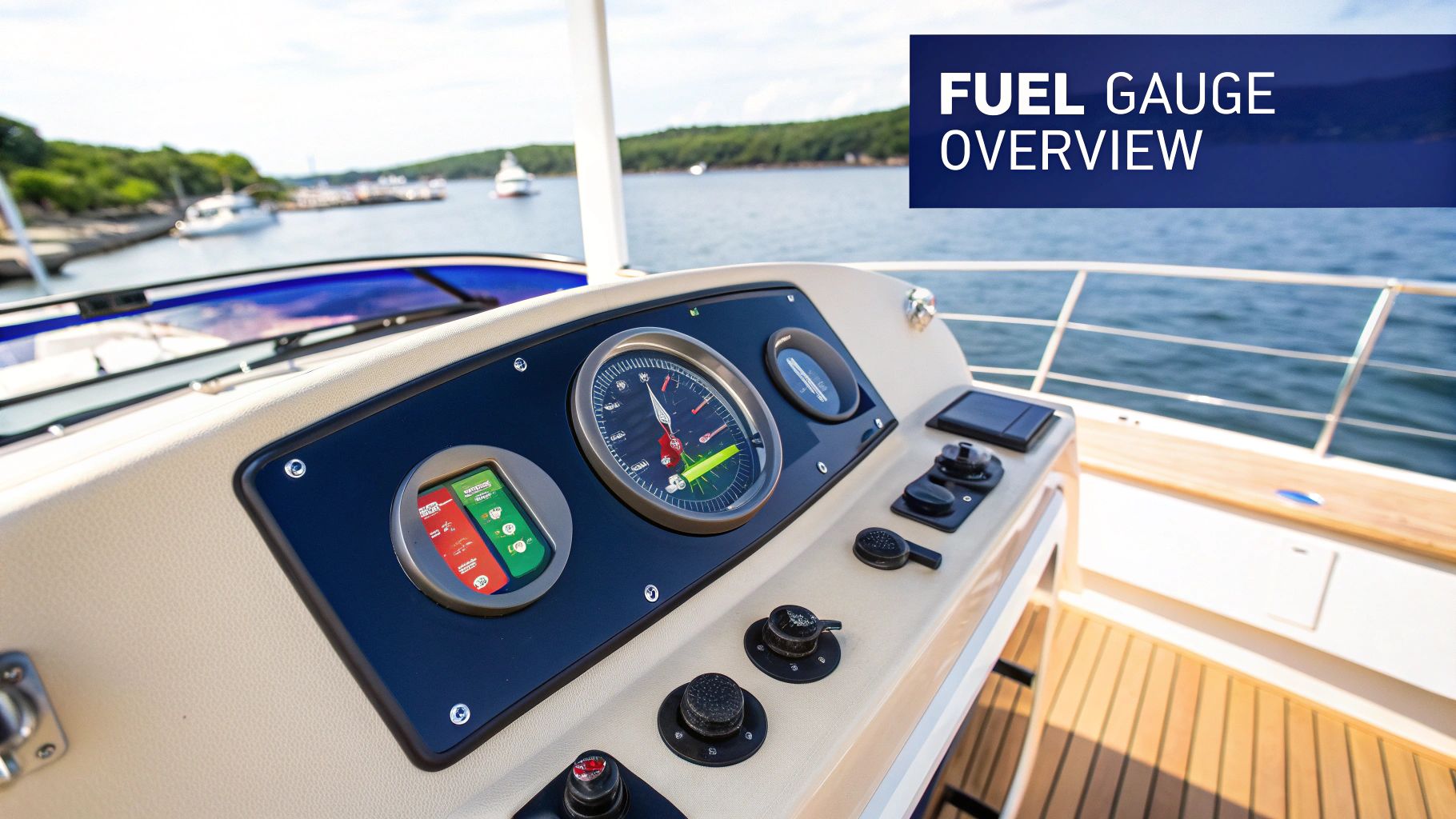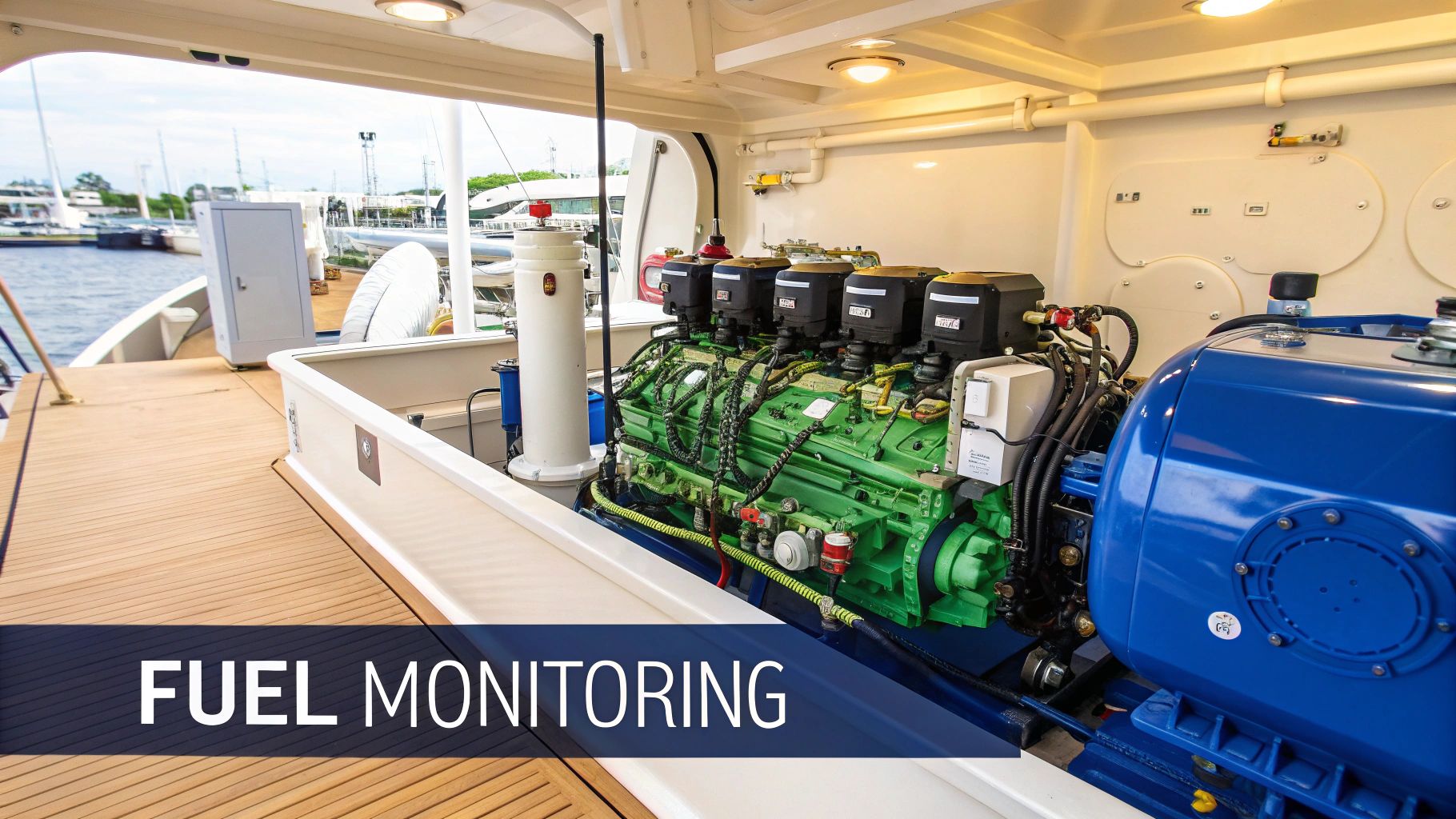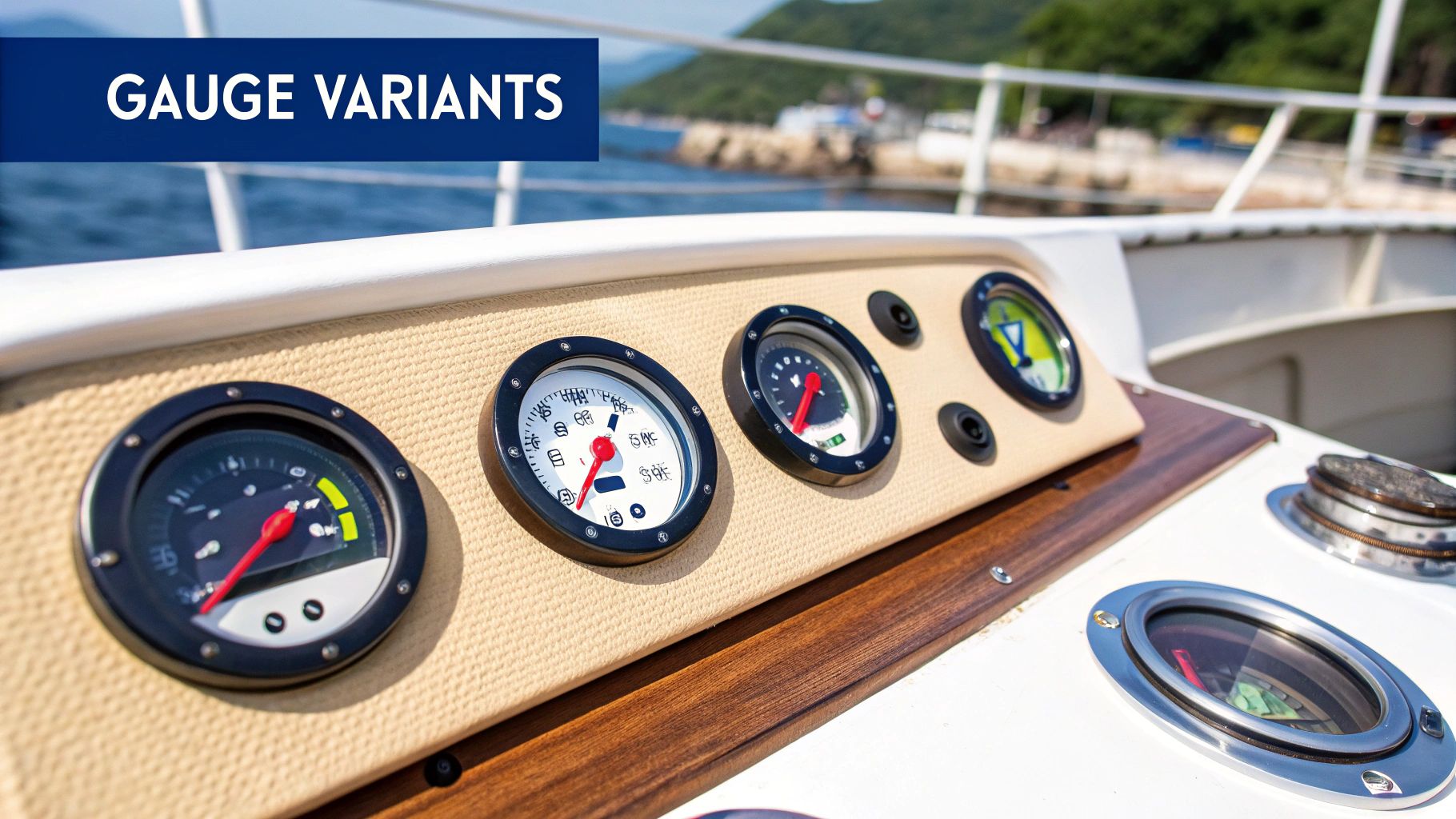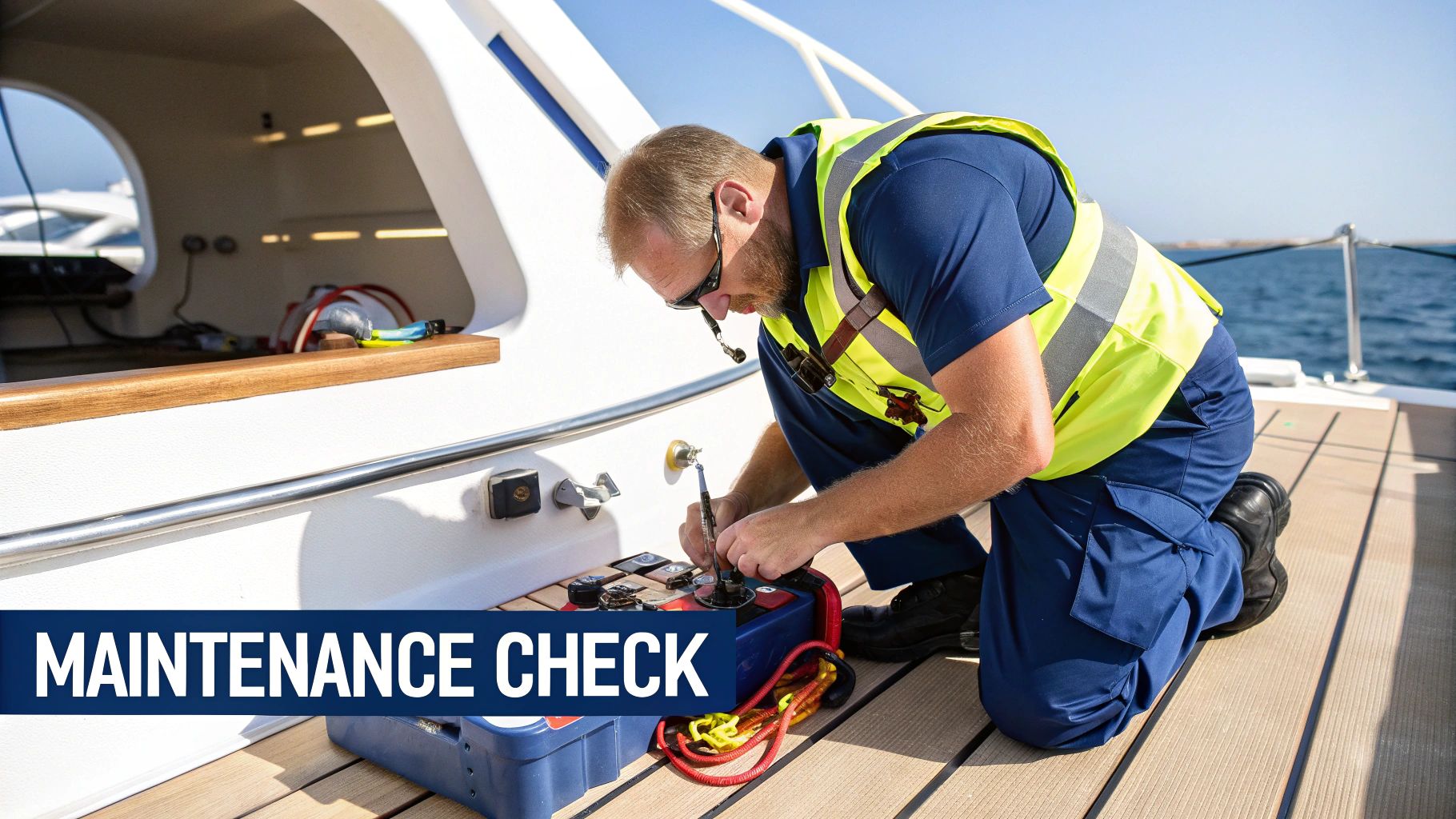The Reality Behind Marine Fuel Gauge Technology

Let's be honest: relying solely on your marine fuel gauge can be risky. Unlike car fuel gauges, marine gauges face unique challenges. The constant rocking of the boat, irregularly shaped fuel tanks, and the corrosive nature of saltwater all contribute to inaccurate readings. Understanding the technology behind these gauges is crucial for every boater. Inaccurate fuel readings can lead to unexpected and potentially dangerous situations out on the water. You might find helpful information in our blog articles.
From Floats To Digital Sensors: The Evolution of Marine Fuel Gauges
Traditional float-type gauges have been the standard for a long time. These systems work by using a float connected to a variable resistor. The float's position translates into a fuel level reading. However, the movement of fuel in a boat significantly affects the float, causing unreliable measurements. Imagine trying to measure water in a shaking bucket – the readings would be inconsistent. This inherent inaccuracy has led to the development of better technologies.
Advances in marine electronics have brought more sophisticated options. Systems using ultrasonic sensors and capacitive sensing offer greater accuracy. They measure fuel level by analyzing sound wave reflection or changes in electrical capacitance. The increasing use of NMEA 2000 networking allows integration of fuel flow sensors, providing real-time fuel consumption and range data. This integrated approach marks a significant improvement in fuel management.
Accuracy Challenges and Real-World Performance
Even these newer systems have limitations. The accuracy of marine fuel gauges varies depending on the boat type and conditions. Modern systems like NMEA 2000 aim for better readings by integrating sensors into the fuel system. But even these have a margin of error. One boater reported their NMEA 2000 gauge was within 2-3% accuracy when compared to actual fuel used.
Older, simpler gauges can be far less accurate. Factors like fuel sloshing in uneven tanks and poor calibration can cause readings to be off by 25% or more. This underscores the need for reliable tracking methods beyond the onboard gauge. Learn more about NMEA 2000 fuel gauge accuracy. This highlights the importance of understanding the limitations of any fuel gauge system.
To help you better understand the various technologies available, let's take a look at the following comparison table:
Marine Fuel Gauge Technologies Comparison
This table compares different marine fuel gauge technologies, their typical accuracy, installation complexity, price range, and what types of boats they are best suited for.
| Gauge Type | Typical Accuracy | Installation Complexity | Price Range | Best For |
|---|---|---|---|---|
| Float-Type | Low (up to 25% error) | Simple | Low | Small boats with simple fuel systems |
| Ultrasonic | Medium (5-10% error) | Moderate | Medium | Larger boats, complex tank shapes |
| Capacitive | High (2-5% error) | Moderate to High | Medium to High | Boats requiring precise fuel management |
| NMEA 2000 Integrated Systems | Very High (1-3% error) | High | High | Modern boats with integrated electronics |
As you can see, different gauge technologies offer different levels of accuracy and complexity. Choosing the right one depends on your specific needs and budget.
While technology continues to improve marine fuel gauge accuracy, it's crucial to understand their limitations. Combining gauge readings with manual fuel tracking and regular maintenance is still the best strategy. This proactive approach helps ensure you are never caught off guard by an inaccurate fuel reading.
Why Your Marine Fuel Gauge Is Lying to You
That seemingly straightforward fuel reading on your boat's gauge can be deceiving. Experienced boaters know marine fuel gauges are notoriously unreliable. Why? Let's explore the reasons behind these inaccuracies and why a healthy dose of skepticism is warranted when checking your boat's fuel.
The Fickle Nature of Fluids and Boats
One of the main culprits behind inaccurate fuel readings is the constant motion of a boat. Unlike a car on a level surface, a boat is always rocking and swaying. This movement causes the fuel inside the tank to slosh around, making it difficult for the fuel gauge sending unit (typically a float-type mechanism) to get a consistent reading. It's like trying to measure water in a bathtub while someone is splashing – the readings change constantly.
Boat fuel tanks also come in irregular shapes, often designed to fit within the hull's limited space. These unusual shapes make accurate fuel measurement even more challenging. A sending unit might be accurate in one area of the tank but completely off in another. This discrepancy can lead to situations where your gauge shows half a tank, but you're dangerously close to running empty.
Temperature’s Sneaky Influence
Temperature also affects fuel gauge accuracy. Fuel expands as it warms and contracts as it cools. This fluctuation in volume can cause the gauge readings to change. This effect is especially noticeable in boats with metal fuel tanks, which conduct temperature changes more readily. A full tank on a scorching afternoon might appear less full as the temperature drops overnight.
The Engineering Challenges of Marine Fuel Gauges
Boat fuel gauges have historically been unreliable due to several factors, including tank shape and boat movement. In many cases, the gauge might show half a tank when, in reality, you’ve used three-quarters of your fuel. The irregular shape of tanks, designed to fit within the boat's hull, and the constant sloshing of fuel exacerbate this inaccuracy. Discussions on forums like Sailboat Owners highlight these issues, with some boaters reporting significant discrepancies between gauge readings and actual fuel levels. Because of these concerns, many boaters rely on logbooks and fuel metering systems for more accurate fuel tracking. This inherent unreliability underscores the importance of careful fuel management.
Why It Matters: Beyond Inconvenience
A faulty fuel gauge is more than just inconvenient; it's a safety hazard. Inaccurate readings can lead to running out of fuel, leaving you stranded at sea. Therefore, it's crucial for boaters to develop fuel management strategies that go beyond relying solely on the fuel gauge. Understanding your marine fuel gauge's limitations is the first step towards a safer and more enjoyable boating experience.
Breakthrough Solutions in Marine Fuel Monitoring

Traditional marine fuel gauges can be unreliable. A new generation of monitoring solutions offers boaters greater accuracy and control, eliminating guesswork and outdated methods. These advancements mark a significant improvement in marine fuel management.
Digital Flow Meters: Real-Time Fuel Consumption Data
Digital flow meters provide a highly effective solution. Installed directly in the fuel line, these devices measure fuel flow in real time. This gives boaters precise fuel consumption data, allowing for more accurate calculations of remaining fuel.
For instance, a digital flow meter can show exactly how many gallons per hour your engine consumes at a given speed and RPM. This real-time information helps boaters make informed decisions about cruising plans and fuel stops.
Ultrasonic Sensors: Overcoming Tank Shape Challenges
Irregularly shaped tanks can make accurate fuel measurement difficult. Ultrasonic sensors address this challenge with a non-invasive solution. These sensors emit sound waves that reflect off the fuel surface, measuring the distance to calculate fuel volume.
Multiple sensors can be strategically positioned within a tank to accommodate its unique shape. This multi-point sensing significantly improves accuracy, even in tanks designed for complex hull curves. Boaters can therefore enjoy more consistent and reliable fuel readings.
NMEA 2000 Integration: A Connected Fuel Management System
NMEA 2000 networking further elevates marine fuel monitoring. This standardized communication protocol allows various onboard systems, like fuel gauges, flow meters, GPS, and chartplotters, to seamlessly share data. NMEA is a standard that allows for interoperability.
Imagine your chartplotter automatically calculating your range using real-time fuel consumption and destination distance. This integration provides a comprehensive overview of fuel usage, empowering boaters to optimize efficiency and plan trips more precisely.
Separating Hype From Reality: Choosing the Right Solution
Not all new technologies deliver on their promises. Some offer genuine advancements, while others fall short. Boaters should carefully assess their specific needs and budget. Factors like boat size, engine type, and cruising habits should influence their choice of fuel gauge and monitoring system.
- Small recreational boats: A basic digital gauge with an ultrasonic sensor might suffice.
- Larger vessels or those used for extended cruising: An integrated NMEA 2000 system with flow meters and multiple sensors provides comprehensive data.
Evaluate each technology's real-world performance and potential return on investment. Some high-end systems may include features unnecessary for the average boater. Investing in a quality marine fuel gauge is crucial for safe and enjoyable boating. Learn more about CLiX Fueling Solutions for a spill-free fueling experience.
Strategic Fuel Management Beyond the Gauge

A marine fuel gauge, while helpful, offers a limited perspective. Savvy boaters know a comprehensive fuel strategy is crucial for a safe and enjoyable boating experience. This involves more than just checking the gauge; it requires adopting proven methods for accurately assessing your fuel situation.
The Importance of Accurate Fuel Consumption Logs
Detailed fuel logs are the foundation of effective fuel management. Record every fuel purchase, noting the date, location, and amount of fuel. Also, log your engine hours at each fill-up.
This data allows you to calculate your real-world burn rate, a key factor in determining your boat's range.
For instance, if you use 20 gallons of fuel over 10 engine hours, your burn rate is 2 gallons per hour. This simple calculation helps you estimate fuel needs for future trips. You can find more information on boating here.
Calculating Real-World Burn Rates and Safety Margins
Your burn rate changes based on factors like speed, weather conditions, and the weight of passengers and gear. Tracking these variables in your fuel log helps you understand their impact on fuel consumption. This allows for adjustments to your fuel strategy as needed.
Always include a safety margin. Never plan to use all your fuel. A good guideline is the one-third rule:
- One-third of your fuel for the outbound trip
- One-third for the return trip
- One-third reserved for emergencies
This common practice provides a buffer against unexpected situations. Concerns about fuel gauge reliability have led many boaters to adopt this strategy. Boatus offers more detailed information about this and other fuel-related advice. Advances in digital fuel-flow monitoring on newer boats also offer more accurate fuel consumption data.
Adapting to Changing Conditions and Vessel Modifications
Boat modifications, like engine upgrades or added weight, significantly affect fuel consumption. Recalculate your burn rate and adjust your fuel strategy after any changes. Continuous monitoring and adaptation are vital for efficient and safe boating.
Be mindful of weather changes, too. Strong headwinds or currents increase fuel consumption, while calm conditions improve it. These variations require careful planning and a proactive approach to fuel management. Meticulous attention to these details ensures a safe and enjoyable time on the water. Understanding your fuel consumption and preparing for the unexpected is paramount for every boater.
Installation Secrets for Maximum Gauge Performance
A high-quality marine fuel gauge is essential for any boat owner. But even the best gauge is useless if it's not installed properly. A poor installation can lead to inaccurate readings and frustrating problems down the line. This section covers the key installation details that will ensure your marine fuel gauge performs at its best.
Sensor Placement: The Foundation of Accuracy
Accurate fuel readings start with proper sensor placement. The sending unit, the component that measures the fuel level, needs to be installed correctly. Avoid placing it near the corners or baffles of the tank. These areas can cause fuel to pool or swirl, resulting in inconsistent readings. The ideal location is the deepest, most stable part of the tank. This ensures the most accurate measurement of your fuel level.
Wiring Protection: Shielding Against the Elements
The marine environment is harsh. Exposed wiring is susceptible to corrosion, vibration, and damage, which can impact your gauge's performance. Protecting your wiring is key to long-term reliability. Use marine-grade wiring with protective sheathing. Securely fasten all wires away from moving parts and sources of heat or abrasion. This will prevent future problems and ensure consistent, accurate readings.
Calibration: Fine-Tuning for Precision
Calibration is the process of matching your gauge to the sending unit’s output. This ensures the gauge accurately reflects the fuel level in your tank. Many modern gauges offer self-calibration. However, older systems or custom installations may require manual calibration. This fine-tuning process is crucial for precise and dependable readings.
Common Installation Pitfalls to Avoid
Even small installation errors can significantly affect accuracy. One common mistake is not considering the tank's shape. Irregularly shaped tanks may require careful sensor placement or even multiple sensors. Another frequent oversight is improper grounding. A poor ground connection can lead to erratic gauge behavior and inaccurate readings. Correct installation ensures reliable performance.
Maintaining Peak Performance: A Seasonal Approach
Regular maintenance is vital for accurate readings and a long lifespan. A seasonal maintenance schedule helps address potential problems before they affect your gauge's performance. The following table outlines a recommended maintenance schedule.
To help you keep your fuel gauge in top shape, we’ve compiled a simple maintenance schedule. This table outlines the key tasks, their frequency, the skill level required, the necessary tools, and the expected outcome.
Marine Fuel Gauge Maintenance Schedule
| Maintenance Task | Frequency | Skill Level | Tools Required | Expected Outcome |
|---|---|---|---|---|
| Inspect Wiring and Connections | Annually | Beginner | Visual inspection | Identify and address corrosion or loose connections |
| Clean Sending Unit | Annually | Beginner | Cleaning solvent, brush | Remove debris and buildup that can affect accuracy |
| Check Gauge Functionality | Annually | Beginner | Observe gauge operation | Verify accurate readings across the full range |
| Calibrate Gauge (if necessary) | As needed | Intermediate | Calibration tools (if applicable) | Ensure precise fuel level measurement |
Following this schedule will help ensure your gauge remains accurate and reliable.
By following these installation and maintenance tips, you can ensure your marine fuel gauge provides the reliable information you need for a safe and enjoyable boating experience. For a cleaner and more efficient fueling process, check out CLiX Fueling Solutions for both gas and diesel engines. This innovative system helps prevent spills and protects your boat from fuel damage.
Choosing the Perfect Marine Fuel Gauge for Your Vessel

Picking the right marine fuel gauge is a crucial decision for any boat owner. It's more than just grabbing the flashiest model; it's about finding the perfect fit for your vessel and boating style. This guide will help you navigate the options and choose the best fuel monitoring system for your needs. Choosing a marine fuel gauge involves considering the installation process, much like planning a Solar Installation in Nigeria.
Matching Technology to Your Vessel and Needs
The ideal gauge integrates seamlessly with your boat, delivering accurate and reliable data. Several factors play a role in this decision, including vessel size, engine configuration, typical cruising range, and budget.
A small fishing boat used for weekend lake trips, for example, will have different fuel monitoring needs than a large yacht designed for extended offshore voyages. Understanding these differences is essential for making a smart choice.
Analog vs. Digital: Weighing the Options
Analog gauges, the traditional needle-and-dial displays, offer a simple and affordable option. They're generally suitable for smaller boats with basic fuel systems. However, they may be less accurate than digital gauges, particularly in rough conditions.
Digital gauges offer greater precision and often include additional features. These might include fuel flow rate and remaining range estimations. For larger vessels or longer journeys where accurate fuel management is critical, digital gauges are a worthwhile investment.
Standalone Gauges vs. Integrated Networks: Connectivity Considerations
Standalone gauges operate independently, providing a straightforward fuel level reading. This is a practical solution for boats with simple setups. Integrated networks, such as NMEA 2000 systems, connect multiple onboard devices. They share data and enhance overall functionality, offering a more complete picture of fuel consumption for better planning and efficiency.
An integrated system automates fuel burn rate and range calculations, displaying real-time data directly on your chartplotter or navigation displays. This level of integration significantly improves fuel management. For more advanced fueling solutions, you can explore CLiX Fueling product solutions.
Basic vs. Premium: Finding the Right Balance
Basic marine fuel gauges provide essential fuel level information at a budget-friendly price, suitable for boaters with simple needs. Premium gauges offer advanced features, such as multi-tank monitoring, customizable alarms, and data logging. These features are valuable for boaters who need precise fuel management and detailed tracking.
Consider your boating habits. A basic gauge might suffice for weekend trips close to shore. However, for serious offshore cruising, a premium gauge provides peace of mind and enhanced fuel management.
Real-World Examples: Choosing the Right Technology for Your Boating Scenario
- Weekend Lake Outings: A simple analog or basic digital gauge is perfectly adequate for short trips in calm waters.
- Coastal Cruising: A digital gauge with fuel flow rate and remaining range estimations is beneficial for longer trips and changing conditions.
- Extended Offshore Cruising: An integrated NMEA 2000 system with multiple sensors and advanced features delivers the most comprehensive fuel management solution for challenging voyages.
Investing Wisely: Maximizing Returns and Avoiding Diminishing Value
Choosing the right gauge involves balancing functionality with cost. Premium features are appealing, but not always necessary. Assess your specific needs and avoid overspending on features you won't use. A high-end integrated system might be excessive for a small fishing boat. A simpler, more affordable gauge would likely be sufficient. Focus on features that enhance your boating experience and fit your budget.
Ready for a hassle-free fueling experience? Check out CLiX Fueling Solutions and eliminate spills and fuel-related worries. This innovative system automatically stops the fuel nozzle when your tank is full, protecting your boat and the environment. Available in both diesel and gas models, CLiX Fueling provides peace of mind on the water.












